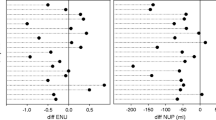Abstract
Prospective controlled studies on the treatment of enuresis with desmopressin (DDAVP) indicate that cure rates (complete dryness) while on therapy are markedly lower than are response rates (decrease in wet nights). In an attempt to explain this discrepancy, we analyzed the etiological mechanisms for enuresis and found evidence that most children are not cured by DDAVP because their nocturnal wetting is not actually caused by the defect which DDAVP therapy aims to cure: low nocturnal vasopressin secretion with high nocturnal urinary output. Our study suggested that an arrest in the normal development of two separate areas of the central nervous system is necessary for enuresis to occur in many patients, yet cure of enuresis occurs if either developmental delay is eliminated. This hypothesis of a dual developmental delay helps to unify many diverse and often seemingly contradictory scientific observations about this condition and to explain why many patients react inconsistently to treatment aimed at a single etiology, yet eventually become dry.
Similar content being viewed by others
References
Bloom DA (1993) The American experience with desmopressin. Clin Pediatr (Phila) special edition: 28–31
Moffatt MEK, Harlos S, Kirshen AJ, Burd L (1993) Desmopressin acetate and nocturnal enuresis: how much do we know? Pediatrics 92: 420–425
Rittig S, Knudsen UB, Sorensen S, Djurhuus JC, Norgaard JP (1989) Abnormal diurnal rhythm of plasma vasopressin and urinary output in patients with enuresis. Am J Physiol 256: 664
Steffens J, Netzer M, Isenberg E, Alloussi S, Ziegler M (1993) Vasopressin deficiency in primary nocturnal enuresis. Results of a controlled prospective study. Eur Urol 24: 366–370
Kawauchi A, Watanabe H (1993) Development of bladder capacity, nocturnal urinary volume and urinary behavior in non-enuretic and enuretic children. Jpn J Urol 84: 1811–1820
Winberg J (1959) Determination of renal concentration capacity in infants and children without renal disease. Acta Paediatr Scand 48: 318
Rascher W, Rauh W, Brandeis WE, Huber KH, Sharer K (1986) Determinants of plasma arginine-vasopressin in children. Acta Paediatr Scand 75: 111–117
Knudsen UB, Rittig S, Norgaard JP, Lundemose JB, Pedersen EB, Djurhuus JC (1991) Long term treatment of nocturnal enuresis with desmopressin. Urol Res 19: 237–240
Aschoff J (1965) Circadian rhythms in man: a self-sustained oscillator with an inherent frequency underlies 24-hour periodicity. Science 148: 1427–1432
Moore-Ede MC (1986) Physiology of the circadian timing system: predictive vs reactive homeostasis. Am J Physiol 250: 737–752
Kawauchi A, Watanabe H, Kitamori T, Imada N, Ohne T (1993) The possibility of centripetal stimulation from the urinary bladder for vasopressin excretion. J Kyoto Pref Univ Med 102: 747–752
Ohne T (1995) The increase in c-Fos expression in vasopressin-and oxytocin-immunoreactive neurons in paraventricular and supraoptic nucleus of the hypothalamus following urinary retention. J Kyoto Pref Univ Med 104: 393–403
Norgaard JP, Hansen JH, Nielsen JB, Rittig S, Djurhuus JC (1989) Nocturnal studies in enuretics. A polygraphic study of sleep-EEG and bladder activity. Scand J Urol Nephrol 125: 73–78
Gillin JC, Rapoport JL, Mikkelsen EJ, Langer D, Vanskiver C, Mendelson W (1982) EEG sleep patterns in enuresis: a further analysis and comparison with normal controls. Biol Psychiatry 17: 947–953
Geirson G, Lindstrom S, Fall M, Gladh G, Hermansson G, Hjalmas K (1994) Positive bladder cooling test in neurologically normal young children. J Urol 151: 446–448
Norgaard JP (1989) Urodynamics in enuretics. I. Reservoir function. Neurourol Urodyn 8: 199–211
Norgaard JP, Hansen JH, Wildschiotz G, Sorensen S, Rittig S, Djurhuus JC (1989) Sleep cystometries in children with nocturnal enuresis. J Urol 141: 1156–1159
Norgaard JP, Rittig S, Djurhuus JC (1989) Nocturnal enuresis: an approach to treatment based on pathogenesis. J Pediatr 114: 705–710
Robert M, Averous M, Besset A, Carlander B, et al (1993) Sleep polygraphic studies using cystomanometry in twenty patients with enuresis. Eur Urol 24: 97–102
Watanabe H, Azuma Y (1989) A proposal for a classification system of enuresis based on overnight simultaneous monitoring of electroencephalography and cystometry. Sleep 12: 257–264
Watanabe H, Kawauchi A, Kitamori T, Azuma Y (1994) Treatment system for nocturnal enuresis according to an original classification system. Eur J Urol 25: 43–50
Author information
Authors and Affiliations
Rights and permissions
About this article
Cite this article
Koff, S.A. Cure of nocturnal enuresis: why isn’t desmopressin very effective?. Pediatr Nephrol 10, 667–670 (1996). https://doi.org/10.1007/s004670050186
Received:
Accepted:
Issue Date:
DOI: https://doi.org/10.1007/s004670050186




